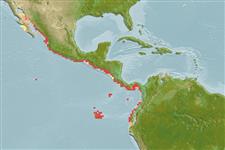Environment: milieu / climate zone / depth range / distribution range
Écologie
marin; saumâtre; profondeur 0 - 50 m (Ref. 189). Tropical; 30°N - 5°S, 115°W - 76°W (Ref. 189)
Eastern Pacific: Magdalena Bay, Baja California on the Pacific coast and from San Felipe Bay, Gulf of California south to Gulf of Guayaquil, northern Peru.
Length at first maturity / Taille / Poids / Âge
Maturity: Lm 10.8, range 11 - 11 cm
Max length : 25.0 cm TL mâle / non sexé; (Ref. 96339); common length : 12.5 cm SL mâle / non sexé; (Ref. 9298); poids max. publié: 57.40 g (Ref. 91172)
Description synthétique
Clés d'identification | Morphologie | Morphométrie
Épines dorsales (Total) : 0; Épines anales: 0; Rayons mous anaux: 26 - 29. Snout moderate, pointed, tip at or just above eye center; maxilla moderate, tip pointed and reaching onto pre-operculum (but not beyond), extending beyond second supra-maxilla; sub-operculum with a distinct triangular projection on hind margin; lower gill rakers fine and slender, increasing in larger fishes. Silver stripe along flank ,probably disappearing in larger fishes.
Occurs inshore along sandy beaches and in tide streams, forming large schools. Juveniles to about 7 cm occur on beaches and in bays, thereafter moving further from the shore. Feeds by filtering phytoplankton and zooplankton.
Life cycle and mating behavior
Maturité | Reproduction | Frai | Œufs | Fécondité | Larves
Spawn in school (Ref. 205).
Whitehead, P.J.P., G.J. Nelson and T. Wongratana, 1988. FAO Species Catalogue. Vol. 7. Clupeoid fishes of the world (Suborder Clupeoidei). An annotated and illustrated catalogue of the herrings, sardines, pilchards, sprats, shads, anchovies and wolf-herrings. FAO Fish. Synop. 125(7/2):305-579. Rome: FAO. (Ref. 189)
Statut dans la liste rouge de l'IUCN (Ref. 130435: Version 2024-1)
Menace pour l'homme
Harmless
Utilisations par l'homme
Pêcheries: intérêt commercial mineur; appât: usually
Outils
Articles particuliers
Télécharger en XML
Sources Internet
Estimates based on models
Preferred temperature (Ref.
123201): 22.3 - 28.5, mean 26.3 °C (based on 48 cells).
Phylogenetic diversity index (Ref.
82804): PD
50 = 0.6250 [Uniqueness, from 0.5 = low to 2.0 = high].
Bayesian length-weight: a=0.00617 (0.00407 - 0.00934), b=3.23 (3.11 - 3.35), in cm total length, based on LWR estimates for this species & (Sub)family-body (Ref.
93245).
Niveau trophique (Ref.
69278): 2.7 ±0.30 se; based on food items.
Résilience (Ref.
120179): Haut, temps minimum de doublement de population inférieur à 15 mois (Preliminary K or Fecundity.).
Fishing Vulnerability (Ref.
59153): Low vulnerability (15 of 100).
Nutrients (Ref.
124155): Calcium = 203 [123, 453] mg/100g; Iron = 1.52 [0.82, 2.66] mg/100g; Protein = 18.4 [16.9, 19.8] %; Omega3 = 0.279 [0.138, 0.566] g/100g; Selenium = 45.1 [20.5, 107.6] μg/100g; VitaminA = 15.1 [4.1, 40.9] μg/100g; Zinc = 2.04 [1.41, 3.05] mg/100g (wet weight);
